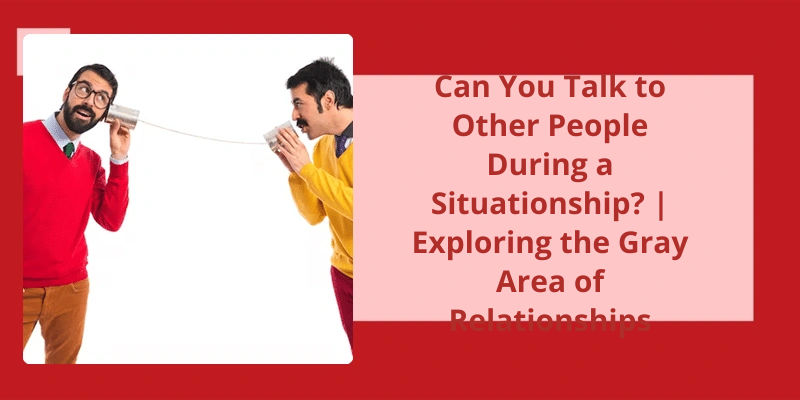The world of dating and relationships can be full of confusing and ambiguous terms. One such term is "situationship," which refers to a relationship that’s somewhere between a friendship and a full-blown romantic relationship. Whether it's because of a lack of commitment, ambiguity, or just a desire to keep things casual, situationships are becoming more and more common. But with this type of relationship comes it’s own set of rules and expectations, or lack thereof. One of those expectations is whether you can talk to other people during a situationship. While this may be a hard question to answer definitively, there are certain patterns and characteristics of these relationships that can help shed light on the matter.
Are There Rules in a Situationship?
One of the main factors that differentiate a situationship from an actual relationship is the lack of defined rules and expectations. With no labels or commitments involved, people involved in situationships are free to pursue other options without any consequence. This can be liberating in some ways, but it can also lead to feelings of uncertainty and confusion. Therefore, it’s crucial to establish some ground rules to make sure both parties are on the same page.
One of the first rules to set in a situationship is the level of exclusivity involved. Are you allowed to see other people, or should you focus solely on each other? It’s important to be honest and clear about this aspect to avoid any misunderstandings or jealousy. Furthermore, agreeing on the frequency and mode of communication can help avoid any misinterpretations and keep things on track.
Another crucial aspect of a situationship is how much time you spend together. Are you going to see each other occasionally, or is it going to be a regular occurrence? Agreeing on a set schedule and sticking to it can help avoid any confusion or frustration and make both parties feel valued. Being flexible and understanding about each others availability is also essential in situationships.
To make a situationship work, it’s also important to set boundaries. This can mean different things for different people, but it usually involves deciding how intimate you want to get. Are you comfortable with casual sex or more physical intimacy, or do you prefer to keep things platonic? It’s essential to communicate your needs and limits clearly to avoid any unwanted or uncomfortable situations.
Finally, it’s important to recognize that situationships can sometimes lead to emotional attachment and feelings of exclusivity. Therefore, it’s always a good idea to have an exit strategy in case one of the parties starts to develop stronger feelings. Committing to revisit the boundaries and rules regularly can also help keep things clear and respectful in a situationship. Overall, while there are no strict rules set in stone, clear communication and mutual respect are key to making a situationship work for both parties involved.
How to Handle Conflicts and Disagreements in a Situationship
- Listen actively and with an open mind
- Express your feelings clearly and calmly
- Avoid blaming or attacking the other person
- Focus on finding a solution together
- Communicate clearly and respectfully
- Take a break if necessary and come back to the discussion
- Compromise and find common ground
- Respect each other’s opinions and differences
- Don’t hold grudges or bring up past conflicts
- Remember that conflicts are a natural part of any relationship
Communication is key in any relationship, and it’s no different in a situationship. It can be tough to navigate the murky waters of a situationship, but having an open and honest conversation with your partner can bring much-needed clarity. In fact, experts recommend taking the time to check in with your partner and ask how they feel about the relationship. It might not be an easy conversation to have, but the end result will be worth it.
How Do You Communicate in a Situationship?
Communication is key in any relationship, and a situationship is no exception. It’s important to establish boundaries and expectations early on, and to be honest and clear about your intentions. This can help prevent misunderstandings and confusion down the line.
This can involve asking open-ended questions, being receptive to their perspectives, and showing empathy and understanding. It’s important to avoid making assumptions or jumping to conclusions, and to approach the conversation with an open mind and a willingness to compromise.
In addition to verbal communication, nonverbal communication can also play a role in a situationship. This can involve paying attention to your partners body language and facial expressions, and being aware of your own nonverbal cues. For example, avoiding eye contact or crossing your arms can signal defensiveness or discomfort, while maintaining open body language and making eye contact can demonstrate warmth and engagement.
How to Navigate Conflicts in a Situationship
A situationship refers to a romantic relationship that isn’t yet labeled as a full-on partnership. Navigating conflicts in a situationship involves acknowledging the differences and understanding each other’s perspective. Effective communication, active listening, and compromise are important skills to use in resolving conflicts. It’s important to establish clear boundaries and expectations, and to prioritize mutual respect to maintain a healthy situationship.
Source: Are You in a Situationship? Here’s How to Tell (and What to Do).
If you’ve been in a situationship and want to take things to the next level, there are some things you’ll need to do to turn it into a bonafide relationship. While it may be scary to step outside of what’s comfortable, the rewards can be worth it. So how do you navigate this tricky transition? Let’s take a look.
Can a Situationship Turn Into a Relationship?
Firstly, it’s important to understand the difference between a situationship and a relationship. A situationship is when two people are romantically involved but aren’t officially in a committed relationship. It often involves ambiguous boundaries, unclear expectations, and a lack of communication about the future. On the other hand, a relationship is a clear commitment to each other, with defined expectations and emotional investment.
To turn a situationship into a relationship, it requires both parties to have an open and honest conversation about where they stand. This can be intimidating, especially if you fear rejection or vulnerability. However, it’s essential to communicate your feelings and desires to the other person to determine if there’s potential for a future together.
Next, it’s important to establish clear boundaries and expectations. This means both parties need to define what they want from the relationship and what they’re willing to invest. It may involve discussing exclusivity, physical boundaries, emotional expectations, and future plans. This can be a challenging conversation, but it’s necessary to avoid hurt feelings and misunderstandings down the road.
Building trust and connection is key to transitioning from a situationship to a relationship. This means investing time and effort into getting to know each other on a deeper level. It can involve spending more quality time together, sharing personal stories, and creating shared experiences. It’s also important to communicate openly and honestly with each other, sharing your thoughts and feelings without fear of judgment or rejection.
Patience and persistence are essential in turning a situationship into a relationship. It may take time to establish a solid foundation of trust, communication, and emotional connection. It’s important to be consistent in your efforts and to continue to prioritize the relationship. This means showing up for each other, making time for each other, and making an effort to keep the connection strong.
How to Identify if You Are in a Situationship or a Relationship
To differentiate between a situationship and a relationship, pay attention to the level of commitment and communication present. Situationships tend to lack clear labels, boundaries and commitments, and there’s often little communication surrounding the status of the relationship. Relationships, on the other hand, are built on mutual commitment and communication, where both parties have defined the relationship and their expectations of it.
In fact, some people prefer situationships as a way to date without the pressure of defining the relationship. When approached with honesty and respect, these types of connections can offer a level of freedom and flexibility that a traditional monogamous relationship may not. But like any type of relationship, communication and boundaries are key to making it work.
Can a Situationship Be Good?
When two people enter a situationship, it’s usually because they aren’t interested in labeling their connection or putting pressure on each other to commit. Situationships can be a great way to escape the rigid definitions that society often imposes on relationships. They offer a chance to explore your feelings and those of your partner without the constraints of expectations, which can be liberating in many ways.
Moreover, situationships are an excellent way to learn more about yourself. These relationships allow you to reflect on your own desires, needs, and boundaries. Taking the time to get to know someone before committing to a traditional relationship can be a beautiful thing. It enables you to assess whether this person aligns with your long-term ambitions and goals, and if not, you can easily move on without getting hurt.
However, this isn’t to say that situationships don’t have their downsides. In some cases, they can be confusing, emotional, and even painful, primarily if the other party develops feelings that aren’t reciprocated. It’s essential to keep clear communication in such scenarios and be honest about your intentions from the get-go.
Ultimately, whether a situationship is good or not depends on the people involved. It takes a lot of understanding, communication, and boundaries to make a situationship work. However, if both parties show a willingness to be open and transparent, it can lead to a beautiful, liberating connection, free from societal pressures and expectations.
They’re an excellent way to explore connections with others without feeling pressured to label them, which can be empowering. And while they may sometimes come with emotional challenges, these relationships can offer profound insights into oneself and others. So, if a situationship is what feels right for you, go for it, and enjoy the ride with honesty and clarity.
Conclusion
At the end of the day, the decision to talk to other people during a situationship lies with the individuals involved. While some may opt for exclusivity, others may prefer the freedom to explore their options without the weight of commitment. Ultimately, it's crucial to have open and honest communication about expectations and boundaries to avoid misunderstandings and hurt feelings. Whether you choose to see other people or not, it's important to respect each other's choices and prioritize mutual respect, honesty, and trust in any type of relationship.






